MITSUBISHI OUTLANDER 2019 Owner's Manual (in English)
Manufacturer: MITSUBISHI, Model Year: 2019, Model line: OUTLANDER, Model: MITSUBISHI OUTLANDER 2019Pages: 451, PDF Size: 58.02 MB
Page 381 of 451
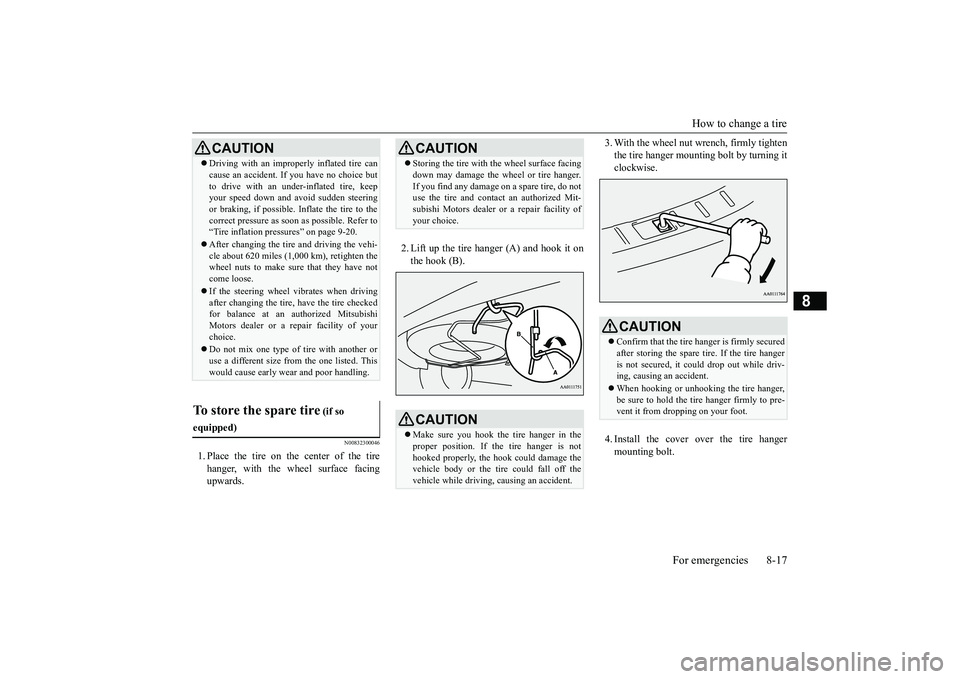
How to change a tire
For emergencies 8-17
8
N00832300046
1. Place the tire on the center of the tire hanger, with the wheel surface facing upwards.
2. Lift up the tire hanger (A) and hook it on the hook (B).
3. With the wheel nut wrench, firmly tighten the tire hanger mounting bolt by turning itclockwise. 4. Install the cover over the tire hanger mounting bolt.
CAUTION Driving with an imprope
rly inflated tire can
cause an accident. If
you have no choice but
to drive with an under-inflated tire, keepyour speed down and avoid sudden steering or braking, if possible. Inflate the tire to the correct pressure as s
oon as possible. Refer to
“Tire inflation pressures” on page 9-20. After changing the tire
and driving the vehi-
cle about 620 miles (1,000 km), retighten the wheel nuts to make sure
that they have not
come loose. If the steering wheel vibrates when driving after changing the tire, have the tire checkedfor balance at an authorized Mitsubishi Motors dealer or a repair facility of your choice. Do not mix one type of tire with another or use a different size from the one listed. Thiswould cause ea
rly wear and poor handling.
To store the spare tire
(if so
equipped)
CAUTION Storing the tire with the wheel surface facing down may damage the wheel or tire hanger.If you find any damage
on a spare tire, do not
use the tire and contact an authorized Mit- subishi Motors dealer or a repair facility of your choice.CAUTION Make sure you hook the tire hanger in the proper position. If the tire hanger is nothooked properly, the hook could damage the vehicle body or the tire could fall off the vehicle while driving,
causing an accident.
CAUTIONConfirm that the tire ha
nger is firmly secured
after storing the spare
tire. If the tire hanger
is not secured, it could drop out while driv- ing, causing
an accident.
When hooking or unhooking the tire hanger, be sure to hold the tire hanger firmly to pre- vent it from dropping on your foot.
BK0264300US.book 17 ページ 2018年2月28日 水曜日 午後5時16分
Page 382 of 451
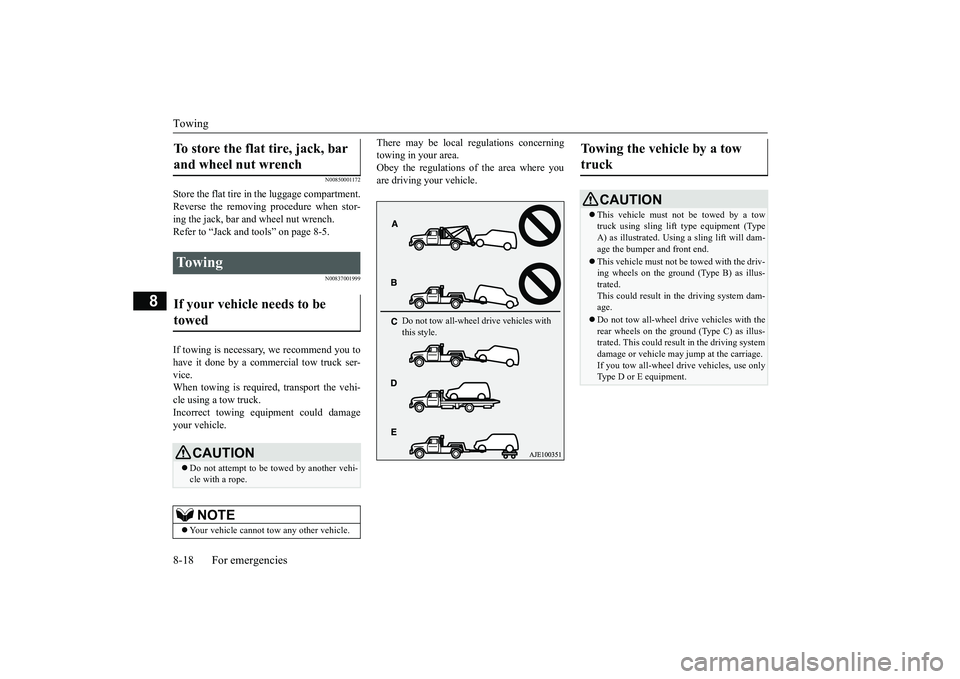
Towing 8-18 For emergencies
8
N00850001172
Store the flat tire in the luggage compartment. Reverse the removing procedure when stor-ing the jack, bar and wheel nut wrench. Refer to “Jack and t
ools” on page 8-5.
N00837001999
If towing is necessary,
we recommend you to
have it done by a commercial tow truck ser- vice. When towing is required, transport the vehi-cle using a tow truck. Incorrect towing equipment could damage your vehicle.
There may be local re
gulations concerning
towing in your area.Obey the regulations of the area where you are driving your vehicle.
To store the flat tire, jack, bar and wheel nut wrench To w i n g If your vehicle needs to be towed
CAUTION Do not attempt to be
towed by another vehi-
cle with a rope.NOTE
Your vehicle cannot
tow any other vehicle.
Do not tow all-wheel drive vehicles with this style.
Towing the vehicle by a tow truck
CAUTION This vehicle must not be towed by a tow truck using sling lift
type equipment (Type
A) as illustrated. Usi
ng a sling lift will dam-
age the bumper and front end. This vehicle must not be towed with the driv- ing wheels on the ground (Type B) as illus- trated. This could result in the driving system dam-age. Do not tow all-wheel drive vehicles with the rear wheels on the ground (Type C) as illus- trated. This could result in the driving system damage or vehicle may
jump at the carriage.
If you tow all-wheel driv
e vehicles, use only
Type D or E equipment.
BK0264300US.book 18 ページ 2018年2月28日 水曜日 午後5時16分
Page 383 of 451
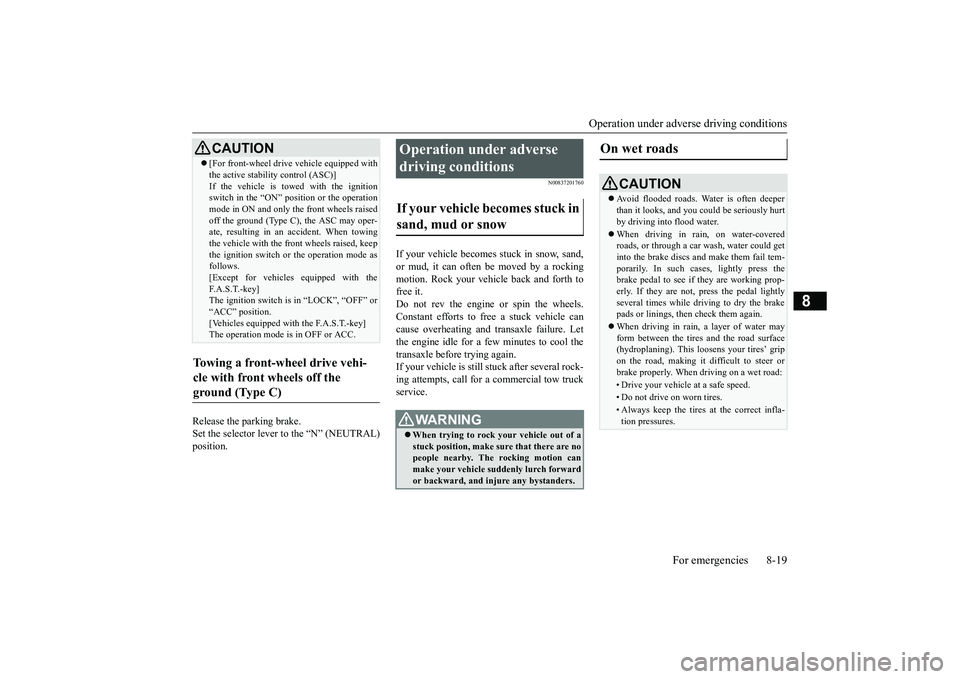
Operation under adverse driving conditions
For emergencies 8-19
8
Release the parking brake. Set the selector lever to the “N” (NEUTRAL) position.
N00837201760
If your vehicle becomes
stuck in snow, sand,
or mud, it can often be moved by a rocking motion. Rock your vehicle back and forth to free it.Do not rev the engine or spin the wheels. Constant efforts to free a stuck vehicle can cause overheating and tr
ansaxle failure. Let
the engine idle for a few minutes to cool the transaxle before trying again. If your vehicle is still
stuck after several rock-
ing attempts, call for a commercial tow truck service.
[For front-wheel driv
e vehicle equipped with
the active stability control (ASC)]If the vehicle is towed with the ignitionswitch in the “ON” pos
ition or the operation
mode in ON and only the front wheels raised off the ground (Type C), the ASC may oper-ate, resulting in an accident. When towing the vehicle with the front wheels raised, keep the ignition switch or
the operation mode as
follows. [Except for vehicles equipped with the F. A . S . T. - k e y ]The ignition switch is in “LOCK”, “OFF” or “ACC” position. [Vehicles equipped with the F.A.S.T.-key]The operation mode is in OFF or ACC.
Towing a front-wheel drive vehi- cle with front wheels off the ground (Type C)
CAUTION
Operation under adverse driving conditions If your vehicle becomes stuck in sand, mud or snow
WA R N I N G When trying to rock
your vehicle out of a
stuck position, make sure that there are nopeople nearby. The
rocking motion can
make your vehicle suddenly lurch forward or backward, and inju
re any bystanders.
On wet roads
CAUTIONAvoid flooded roads. Water is often deeper than it looks, and you could be seriously hurtby driving into flood water. When driving in rain, on water-covered roads, or through a car
wash, water could get
into the brake discs and make them fail tem- porarily. In such cases, lightly press thebrake pedal to see if they are working prop- erly. If they are not, press the pedal lightly several times while driving to dry the brakepads or linings, then check them again. When driving in rain, a layer of water may form between the tires and the road surface (hydroplaning). This loosens your tires’ grip on the road, making it difficult to steer orbrake properly. When driving on a wet road:• Drive your vehicle at a safe speed.• Do not drive on worn tires.• Always keep the tires at the correct infla- tion pressures.
BK0264300US.book 19 ページ 2018年2月28日 水曜日 午後5時16分
Page 384 of 451
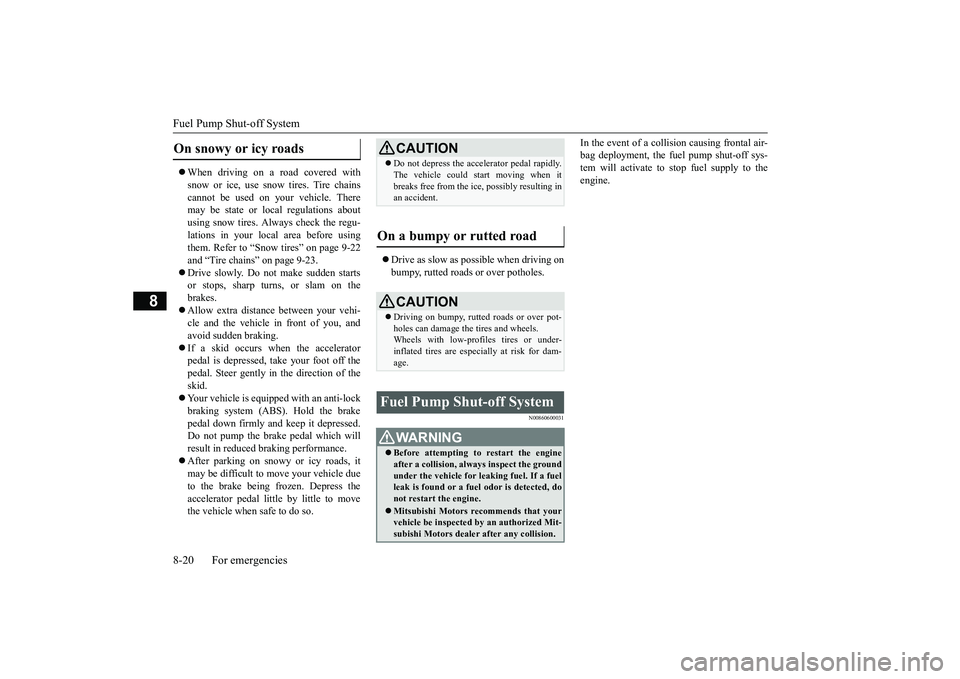
Fuel Pump Shut-off System 8-20 For emergencies
8
When driving on a road covered with snow or ice, use s
now tires. Tire chains
cannot be used on your vehicle. There may be state or local regulations aboutusing snow tires. Al
ways check the regu-
lations in your local area before using them. Refer to “Snow tires” on page 9-22and “Tire chains” on page 9-23. Drive slowly. Do not make sudden starts or stops, sharp turns, or slam on the brakes. Allow extra distance
between your vehi-
cle and the vehicle in front of you, and avoid sudden braking. If a skid occurs when the accelerator pedal is depressed, take your foot off the pedal. Steer gently in the direction of the skid. Your vehicle is equipped with an anti-lock braking system (ABS). Hold the brake pedal down firmly and keep it depressed.Do not pump the brake pedal which will result in reduced braking performance. After parking on snowy or icy roads, it may be difficult to move your vehicle due to the brake being frozen. Depress the accelerator pedal little by little to movethe vehicle when safe to do so.
Drive as slow as pos
sible when driving on
bumpy, rutted roads or over potholes.
N00860600031
In the event of a collision causing frontal air-bag deployment, the fuel pump shut-off sys-tem will activate to st
op fuel supply to the
engine.
On snowy or icy roads
CAUTION Do not depress the acce
lerator pedal rapidly.
The vehicle could start moving when itbreaks free from the
ice, possibly resulting in
an accident.
On a bumpy or rutted road
CAUTION Driving on bumpy, rutted roads or over pot- holes can damage th
e tires and wheels.
Wheels with low-profiles tires or under-inflated tires are especially at risk for dam- age.
Fuel Pump Shut-off System
WA R N I N G Before attempting to restart the engine after a collision, alw
ays inspect the ground
under the vehicle for leaking fuel. If a fuelleak is found or a fuel
odor is detected, do
not restart the engine. Mitsubishi Motors recommends that your vehicle be inspected by
an author
ized Mit-
subishi Motors dealer
after any collision.
BK0264300US.book 20 ページ 2018年2月28日 水曜日 午後5時16分
Page 385 of 451
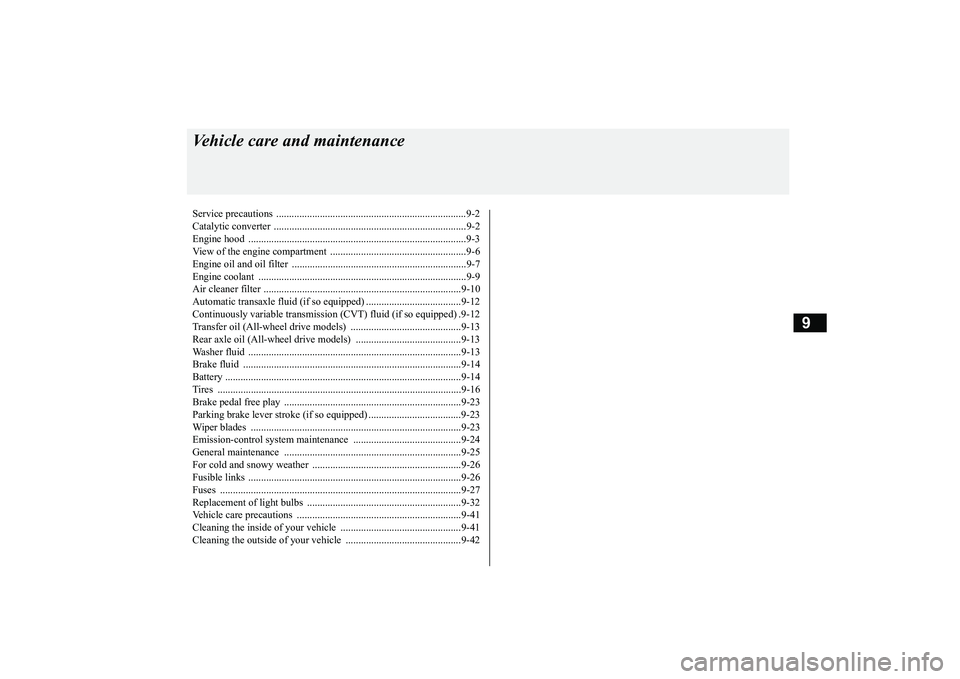
9
Vehicle care and maintenanceService precautions ..........................................................................9-2 Catalytic converter ...........................................................................9-2 Engine hood .........
...........
...........
............
...........
.........
........
.........
.....9-3
View of the engine compartment .....................................................9-6 Engine oil and oil filter ....................................................................9-7 Engine coolant .................................................................................9-9Air cleaner filter .............................................................................9-10 Automatic transaxle fluid (if so equipped) .....................................9-12 Continuously variable transmission
(CVT) fluid (if so equipped) .9-12
Transfer oil (All-wheel drive models) ...........................................9-13 Rear axle oil (All-wheel drive models) .........................................9-13 Washer fluid ...................................................................................9-13Brake fluid .....................................................................................9-14 Battery ............................................................................................9-14 Tires ...............................................................................................9-16Brake pedal free play .....................................................................9-23 Parking brake lever stroke (if so equipped) ....................................9-23 Wiper blades ..................................................................................9-23Emission-control system maintenance ..........................................9-24 General maintenance .....................................................................9-25 For cold and snowy weather ..........................................................9-26Fusible links ...................................................................................9-26 Fuses ..............................................................................................9-27 Replacement of light bulbs ............................................................9-32Vehicle care precautions ................................................................9-41 Cleaning the inside of your vehicle .......
...........
...........
...........
.......9-41
Cleaning the outside of your vehicle .....
...........
...........
...........
.......9-42
BK0264300US.book 1 ページ 2018年2月28日 水曜日 午後5時16分
Page 386 of 451
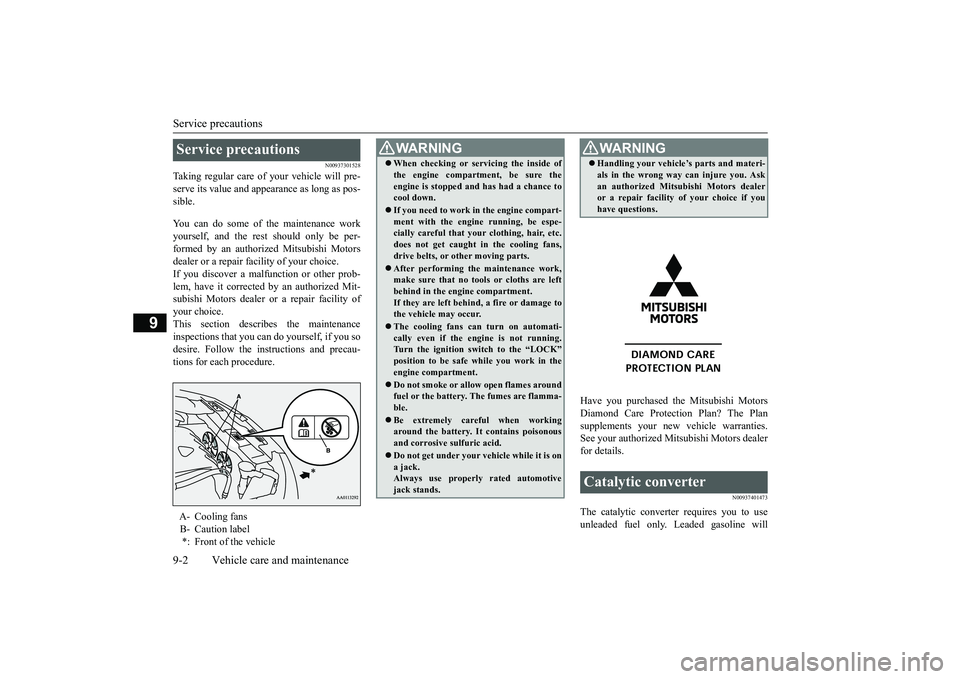
Service precautions 9-2 Vehicle care and maintenance
9
N00937301528
Taking regular care of your vehicle will pre- serve its value and appe
arance as long as pos-
sible. You can do some of the maintenance work yourself, and the rest should only be per- formed by an authorized Mitsubishi Motors dealer or a repair facility of your choice.If you discover a malfunction or other prob- lem, have it corrected by an authorized Mit- subishi Motors dealer or a repair facility of your choice. This section descri
bes the maintenance
inspections that you can do yourself, if you so desire. Follow the instructions and precau- tions for each procedure.
Have you purchased the Mitsubishi Motors Diamond Care Protection Plan? The Plan supplements your new
vehicle warranties.
See your authorized Mitsubishi Motors dealer for details.
N00937401473
The catalytic converter requires you to useunleaded fuel only. Leaded gasoline will
Service precautions A- Cooling fans B- Caution label *: Front of the vehicle
WA R N I N G When checking or servicing the inside of the engine compartment, be sure theengine is stopped and has had a chance tocool down. If you need to work
in the engine compart-
ment with the engine running, be espe- cially careful that your clothing, hair, etc. does not get caught in the cooling fans,drive belts, or other moving parts. After performing the maintenance work, make sure that no tools or cloths are left behind in the engine compartment. If they are left behind, a fire or damage tothe vehicle may occur. The cooling fans can turn on automati- cally even if the engine is not running. Turn the ignition switch to the “LOCK” position to be safe while you work in theengine compartment. Do not smoke or allow open flames around fuel or the battery. The fumes are flamma- ble. Be extremely careful when working around the battery. It
contains poisonous
and corrosive sulfuric acid. Do not get under your ve
hicle while it is on
a jack.Always use properly rated automotive jack stands.
Handling your vehicle’s parts and materi- als in the wrong way can injure you. Askan authorized Mitsub
ishi Motors dealer
or a repair facility of your choice if you have questions.
Catalytic converter
WA R N I N G
BK0264300US.book 2 ページ 2018年2月28日 水曜日 午後5時16分
Page 387 of 451
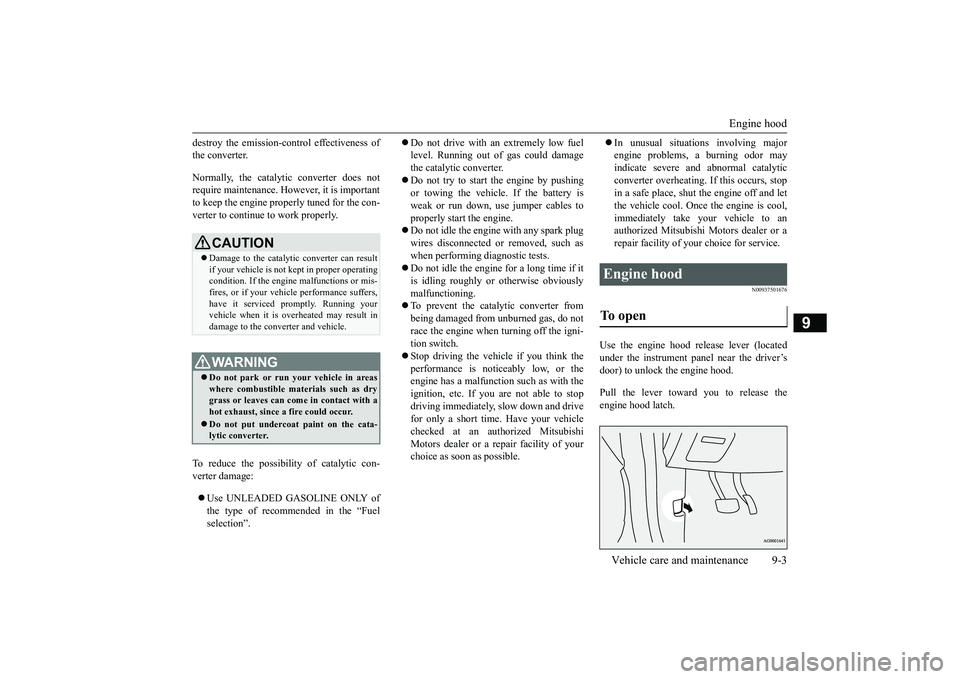
Engine hood
Vehicle care and maintenance 9-3
9
destroy the emission-c
ontrol effectiveness of
the converter. Normally, the catalyti
c converter does not
require maintenance. However, it is important to keep the engine properly tuned for the con- verter to continue to work properly. To reduce the possibili
ty of catalytic con-
verter damage: Use UNLEADED GASOLINE ONLY of the type of recommended in the “Fuelselection”.
Do not drive with an extremely low fuel level. Running out of gas could damagethe catalytic converter. Do not try to start the engine by pushing or towing the vehicle. If the battery isweak or run down, use jumper cables to properly start the engine. Do not idle the engine with any spark plug wires disconnected or removed, such as when performing
diagnosti
c tests.
Do not idle the engine
for a long time if it
is idling roughly or otherwise obviously malfunctioning. To prevent the catalytic converter from being damaged from unburned gas, do not race the engine when turning off the igni-tion switch. Stop driving the vehicle if you think the performance is noticeably low, or theengine has a malfunction such as with the ignition, etc. If you are not able to stop driving immediately,
slow down and drive
for only a short time. Have your vehicle checked at an authorized Mitsubishi Motors dealer or a repair facility of yourchoice as soon
as possible.
In unusual situations involving major engine problems, a burning odor mayindicate severe a
nd abnormal catalytic
converter overheating. If this occurs, stop in a safe place, shut
the engine off and let
the vehicle cool. Once the engine is cool, immediately take your vehicle to an authorized Mitsubishi Motors dealer or arepair facility of your
choice for service.
N00937501676
Use the engine hood release lever (located under the instrument panel near the driver’s door) to unlock the engine hood. Pull the lever toward you to release the engine hood latch.
CAUTION Damage to the catalyti
c converter can result
if your vehicle is not
kept in proper operating
condition. If the engine
malfunctions or mis-
fires, or if your vehi
cle performance suffers,
have it serviced promptly. Running your vehicle when it is
overheated may result in
damage to the converter and vehicle.WA R N I N G Do not park or run your vehicle in areas where combustible materials such as dry grass or leaves can come
in contact with a
hot exhaust, since a fire could occur. Do not put undercoat paint on the cata- lytic converter.
Engine hood To open
BK0264300US.book 3 ページ 2018年2月28日 水曜日 午後5時16分
Page 388 of 451
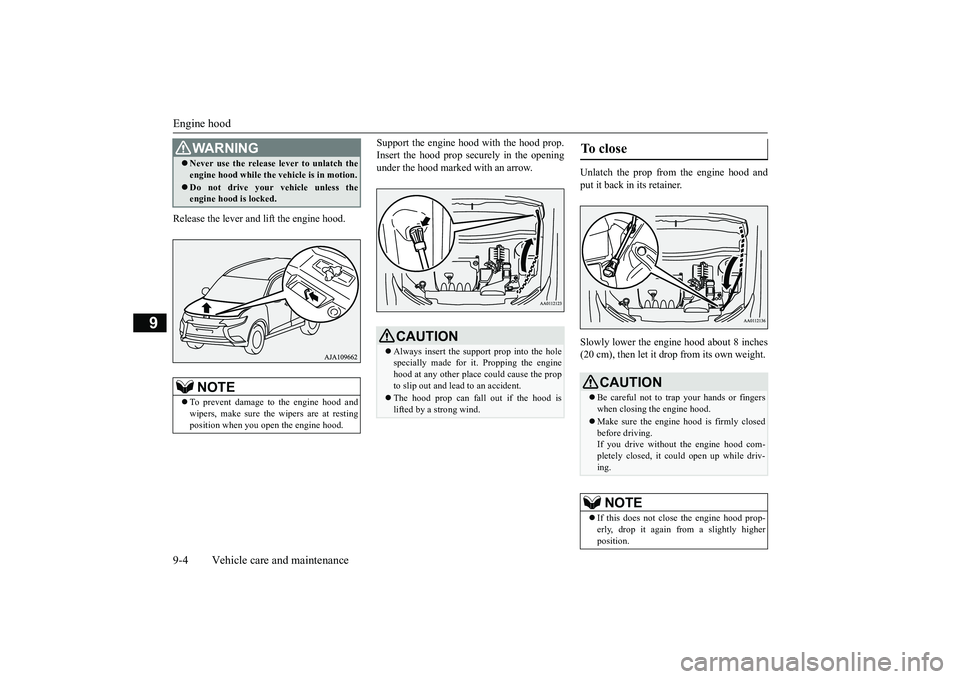
Engine hood 9-4 Vehicle care and maintenance
9
Release the lever and
lift the engine hood.
Support the engine hood with the hood prop. Insert the hood prop securely in the openingunder the hood marked with an arrow.
Unlatch the prop from the engine hood and put it back in its retainer. Slowly lower the engine hood about 8 inches (20 cm), then let it drop from its own weight.
WA R N I N G Never use the release lever to unlatch the engine hood while the
vehicle is in motion.
Do not drive your vehicle unless the engine hood is locked.NOTE
To prevent damage to the engine hood and wipers, make sure the
wipers are at resting
position when you open the engine hood.
CAUTION Always insert the support prop into the hole specially made for it. Propping the engine hood at any other place
could cause the prop
to slip out and lead
to an accident.
The hood prop can fall out if the hood is lifted by a strong wind.
To close
CAUTION Be careful not to trap your hands or fingers when closing the engine hood. Make sure the engine hood is firmly closed before driving. If you drive without the engine hood com- pletely closed, it c
ould open up while driv-
ing.NOTE
If this does not clos
e the engine hood prop-
erly, drop it again from a slightly higher position.
BK0264300US.book 4 ページ 2018年2月28日 水曜日 午後5時16分
Page 389 of 451
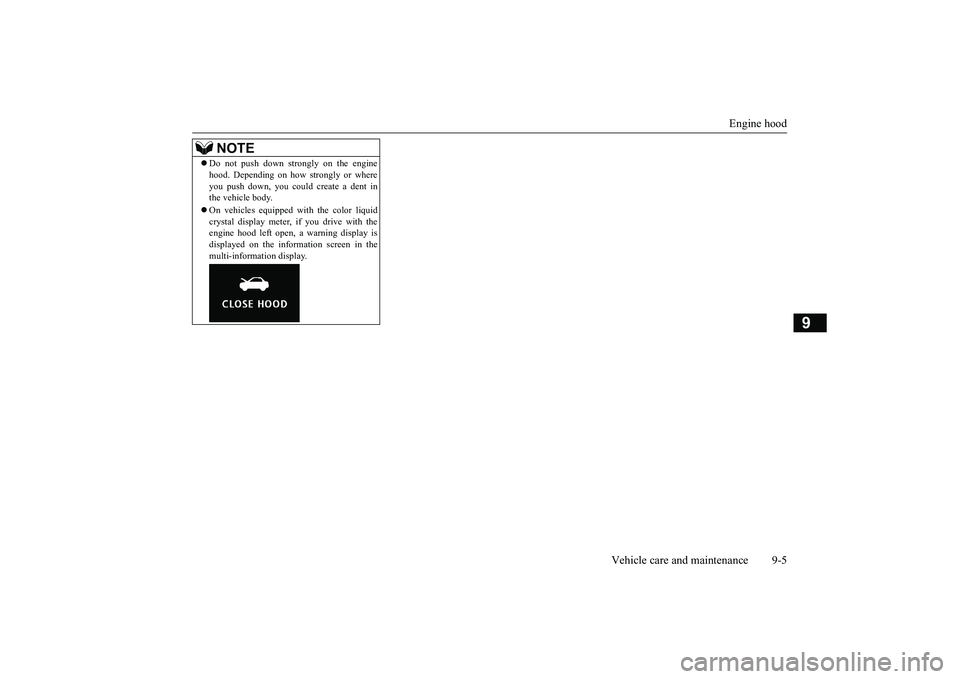
Engine hood
Vehicle care and maintenance 9-5
9
Do not push down strongly on the engine hood. Depending on how strongly or whereyou push down, you could create a dent inthe vehicle body. On vehicles equipped
with the color liquid
crystal display meter,
if you drive with the
engine hood left open, a warning display is displayed on the information screen in themulti-information display.NOTE
BK0264300US.book 5 ページ 2018年2月28日 水曜日 午後5時16分
Page 390 of 451
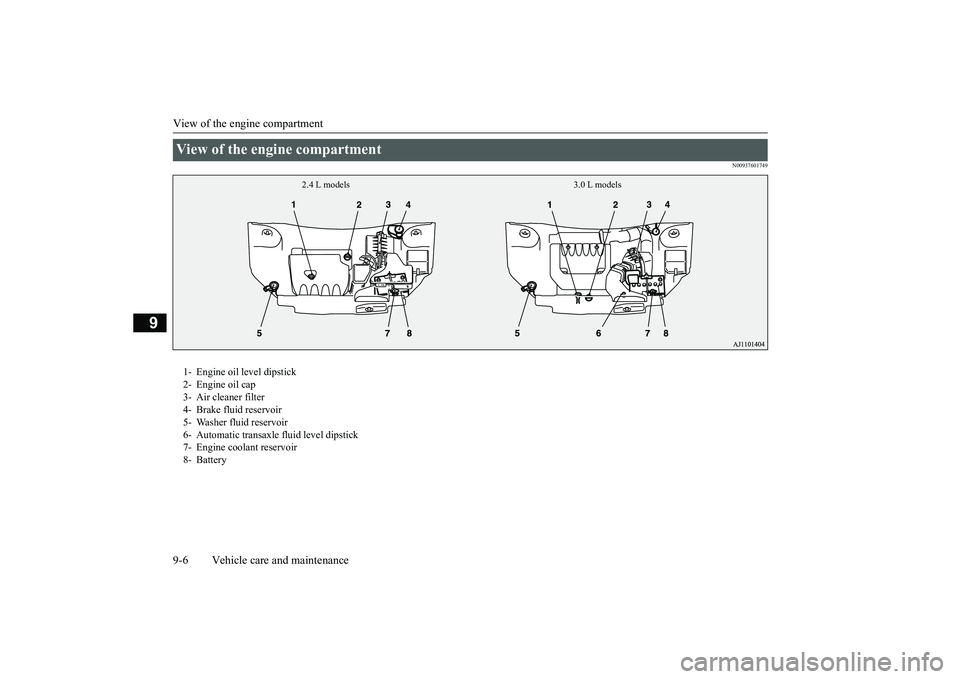
View of the engine compartment 9-6 Vehicle care and maintenance
9
N00937601749
View of the engine compartment
2.4 L models 3.0 L models
1- Engine oil level dipstick 2- Engine oil cap 3- Air cleaner filter4- Brake fluid reservoir 5- Washer fluid reservoir 6- Automatic transaxle
fluid level dipstick
7- Engine coolant reservoir 8- Battery
BK0264300US.book 6 ページ 2018年2月28日 水曜日 午後5時16分